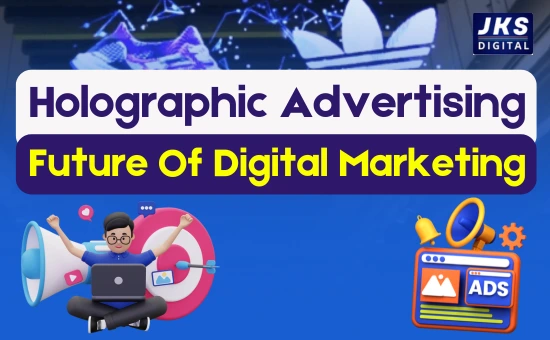Holographic Ads:- Digital marketing is evolving rapidly and new inventions are taking place in the world of advertising. Holographic advertising is one such technology that can completely transform digital advertising. Can you imagine advertising a product floating in the air without any screen? That is the real power of holographic advertising! It is not just a fantasy but a reality in the near future. Let us learn about this unique technology in detail.

1. What are Holographic Ads?
Holographic ads are 3D visuals that are visible without any screen or device. These ads appear floating in the air and can be viewed from a 360° angle. This technology uses lasers, projection, and AR (augmented reality) to create interactive ads that are highly effective in grabbing the attention of customers.
2. How do holographic ads work?
Holographic ads use the following technologies:
- Laser holography: Laser beams are used to create 3D images. This technology provides high-quality displays and is extremely effective.
- Pepper’s Ghost Effect: This is an old technology that uses reflective screens to project images in the air.
- Holophan technology: Rotating blades with LED lights are used to project 3D images in the air.
- AR and VR integration: Some ads can be viewed through AR glasses, which provides users with a virtual experience and allows them to interact with the ad.
3. Impact of holographic ads on digital marketing
- Increased brand engagement: Holographic ads are highly effective in attracting customers.
- Interactivity: Customers can interact with holographic ads, which improves their experience.
- Viral content creation: Unique and engaging ads can quickly go viral on social media.
- On-site marketing: Holographic ads are useful in stores, malls, and events.
4. History of holographic technology
Holographic technology was first introduced by Dennis Gabor in 1947. With the development of laser technology in the 1960s, it gained momentum. Today, this technology is making its mark in advertising, entertainment, healthcare, and education.
5. Current implementation of holographic advertising
Many big companies are now using holographic advertising:
- Coca-Cola: Promotes its products through holographic displays.
- Nike: Showcases its new shoe models in stores using holographic projection.
- Samsung and Apple: Use holographic displays during mobile launch events.
- Automobile brands: Companies like BMW, Audi, and Tesla promote their car models using holographic projection.
In business and marketing:
- For brand promotion, holographic advertising, and product display.
- Companies can create interactive advertisements using 3D holograms.
In education and medical field:
- Hologram projections can display 3D anatomy of the human body in medical science.
- Used for virtual teaching in schools and universities.
In entertainment and events:
- Hologram projectors are used for live shows and movie promotions.
- Example: Michael Jackson’s hologram performance at the 2014 Billboard Music Awards.
In online shopping and retail:
- Customers can view 3D models of products without touching them, which improves the online shopping experience.
- Many big brands are using holographic projectors in their stores.
6. Examples of holographic advertisements
- BMW’s holographic projection: To display car interiors and features.
- Adidas’ Holographic Shoe Display: Providing a 360° view without touching the shoes.
- Star Wars Hologram Ad: An interactive holographic movie promotion.
- KFC’s 3D Holographic Menu: Attracting customers with unique displays.

7. Challenges of Holographic Advertising
High cost: This technology is still expensive.
- Technical limitations: Maintaining accuracy and clarity can be difficult.
- Limited content availability: Very few brands are adopting this technology.
8. Holographic Advertising Machine
Holographic advertising machines are devices that can show advertisements in the air. These machines are usually seen in big companies and shopping malls.
Read More:- Best Free Tools to Get Content Ideas in 2025
9. 3D Holographic Signage
This is a kind of digital signage that shows 3D images and text without any screen. It is used by big brands in stores, shopping malls and airports.
10. Hologram Projector
A hologram projector is an advanced device that uses laser and light projection technology to project 3D images or videos in the air. It can project a three-dimensional (3D) image of an object, text, animation or person in the real world without any screen or physical support.
11. Holographic Display Cost
- Small home hologram projectors can cost between ₹10,000 to ₹50,000.
- Advanced commercial holographic projectors can cost from ₹1,00,000 to ₹10,00,000 or more.
- Brands like HoloVect, Holofan, Looking Glass Factory and HyperVSN are the leaders in holographic display technology.
12. Future Possibilities of Holographic Advertising
- Integration with Metaverse and AR-VR will make this technology even more advanced.
- Holographic video calls and virtual meetings could become common in the future.
- Fully immersive 3D advertising will be possible with holographic projectors.
Read Also:- Local SEO Strategy: Boost Your Business in 2025
Conclusion
Holographic advertising is revolutionizing the way brands connect with their audiences. By offering immersive and interactive experiences, it stands out in the crowded digital marketing space. Unlike traditional ads, holographic ads capture attention effortlessly with their 3D visuals and floating displays, creating memorable experiences for customers.
The integration of holographic technology with AR and VR opens up endless possibilities, from virtual product interactions to lifelike holographic meetings. While challenges like high costs and technical expertise exist, these barriers are likely to reduce as the technology becomes more accessible.
The future of holographic advertising is bright, especially with the rise of the Metaverse and AR/VR adoption. Brands that embrace this technology early will gain a competitive edge, offering cutting-edge experiences that resonate with tech-savvy consumers. In short, holographic advertising is not just a trend—it’s the future of marketing, and businesses that invest in it today will lead tomorrow.

